key RENAULT ZOE 2014 1.G User Guide
[x] Cancel search | Manufacturer: RENAULT, Model Year: 2014, Model line: ZOE, Model: RENAULT ZOE 2014 1.GPages: 214, PDF Size: 4.13 MB
Page 92 of 214
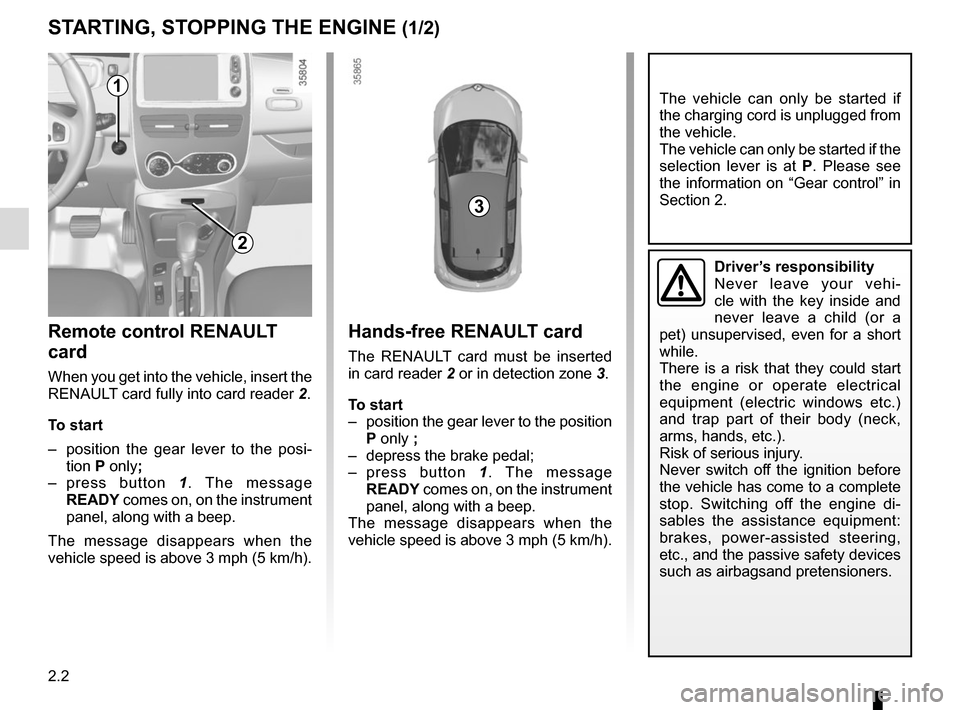
2.2
STARTING, STOPPING THE ENGINE (1/2)
Driver’s responsibility
Never leave your vehi-
cle with the key inside and
never leave a child (or a
pet) unsupervised, even for a short
while.
There is a risk that they could start
the engine or operate electrical
equipment (electric windows etc.)
and trap part of their body (neck,
arms, hands, etc.).
Risk of serious injury.
Never switch off the ignition before
the vehicle has come to a complete
stop. Switching off the engine di-
sables the assistance equipment:
brakes, power-assisted steering,
etc., and the passive safety devices
such as airbagsand pretensioners.
The vehicle can only be started if
the charging cord is unplugged from
the vehicle.
The vehicle can only be started if the
selection lever is at P. Please see
the information on “Gear control” in
Section 2.
Remote control RENAULT
card
When you get into the vehicle, insert the
RENAULT card fully into card reader 2.
To start
– position the gear lever to the posi- tion P only;
– press button 1. The message
READY comes on, on the instrument
panel, along with a beep.
The message disappears when the
vehicle speed is above 3 mph (5 km/h).
Hands-free RENAULT card
The RENAULT card must be inserted
in card reader 2 or in detection zone 3.
To start
– position the gear lever to the position P only ;
– depress the brake pedal;
– press button 1. The message
READY comes on, on the instrument
panel, along with a beep.
The message disappears when the
vehicle speed is above 3 mph (5 km/h).
3
1
2
Page 93 of 214
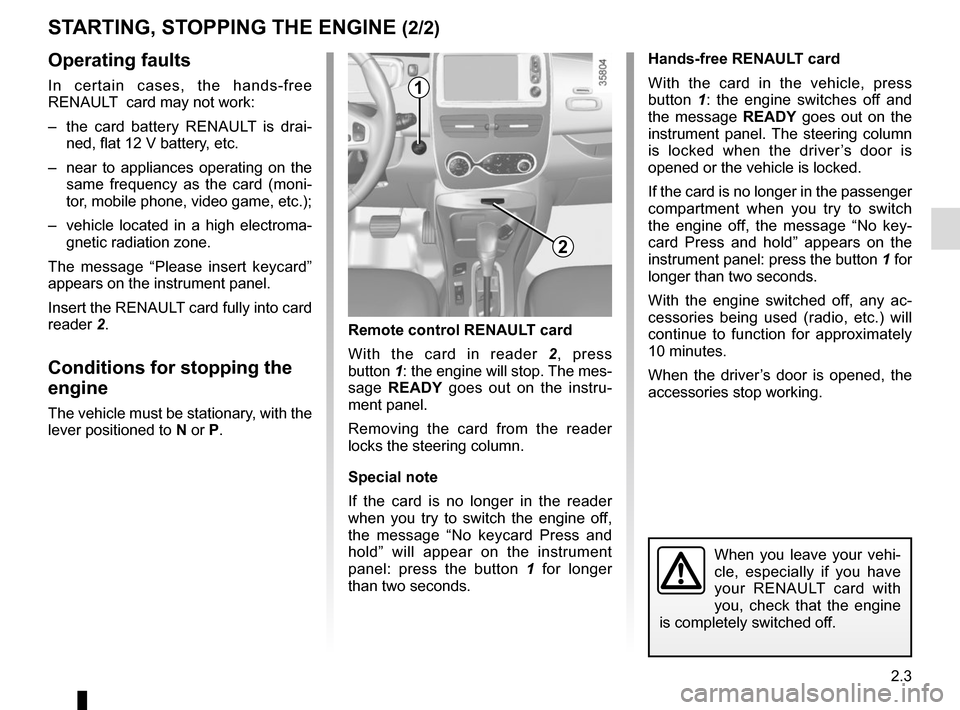
2.3
Operating faults
In certain cases, the hands-free
RENAULT card may not work:
– the card battery RENAULT is drai-ned, flat 12 V battery, etc.
– near to appliances operating on the same frequency as the card (moni-
tor, mobile phone, video game, etc.);
– vehicle located in a high electroma- gnetic radiation zone.
The message “Please insert keycard”
appears on the instrument panel.
Insert the RENAULT card fully into card
reader 2.
Conditions for stopping the
engine
The vehicle must be stationary, with the
lever positioned to N or P.
STARTING, STOPPING THE ENGINE (2/2)
Hands-free RENAULT card
With the card in the vehicle, press
button 1: the engine switches off and
the message READY goes out on the
instrument panel. The steering column
is locked when the driver’s door is
opened or the vehicle is locked.
If the card is no longer in the passenger
compartment when you try to switch
the engine off, the message “No key-
card Press and hold” appears on the
instrument panel: press the button 1 for
longer than two seconds.
With the engine switched off, any ac-
cessories being used (radio, etc.) will
continue to function for approximately
10 minutes.
When the driver’s door is opened, the
accessories stop working.
Remote control RENAULT card
With the card in reader 2 , press
button 1: the engine will stop. The mes-
sage READY goes out on the instru-
ment panel.
Removing the card from the reader
locks the steering column.
Special note
If the card is no longer in the reader
when you try to switch the engine off,
the message “No keycard Press and
hold” will appear on the instrument
panel: press the button 1 for longer
than two seconds.
1
When you leave your vehi-
cle, especially if you have
your RENAULT card with
you, check that the engine
is completely switched off.
2
Page 136 of 214

3.16
Safety of rear occupants
The driver can prevent op-
eration of the rear elec-
tric windows by pressing
switch 4. A confirmation message is
displayed on the instrument panel.
Driver’s responsibility
Never leave your vehicle with the
key inside and never leave a child
(or a pet) unsupervised, even for a
short while. They may pose a risk
to themselves or to others by start-
ing the engine, activating equipment
such as the electric windows or by
locking the doors. If a body part
gets trapped, reverse the direction
of travel of the window as soon as
possible by pressing the relevant
switch.
Risk of serious injury.
ELECTRIC WINDOWS (1/2)
These systems operate with the igni-
tion on or off, until one of the front doors
is opened (limited to about 3 minutes).
From the driver’s seat, use switch:
1 for the driver’s side;
2 for the front passenger side;
3 and 5 for the rear passenger win-
dows.
From the passenger seats, use
switch 6.
Note: if the window detects resistance
when closing (e.g.: fingers, branch of
a tree, etc.) it stops and then lowers
again by a few centimetres.Electric windowsPress or pull the switch to raise or lower
a window to the desired height (the rear
windows do not open fully);
One-touch mode
(depending on vehicle)
This mode works in addition to the
operation of the electric windows de-
scribed previously. It can be fitted to the
driver’s window.
Briefly press or pull the window switch
fully: the window is fully lowered or
raised. Pressing the switch again stops
the window moving.
1
2
34
5
6
Avoid resting any objects against
a half-open window: there is a risk
that the electric window could be
damaged.
Page 177 of 214
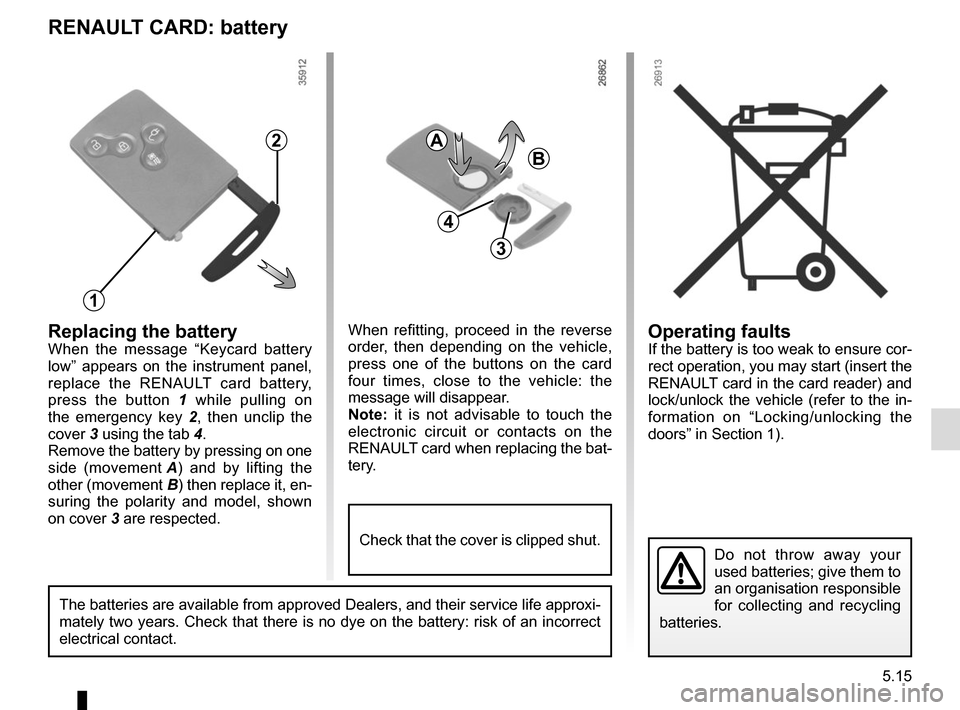
5.15
Operating faultsIf the battery is too weak to ensure cor-
rect operation, you may start (insert the
RENAULT card in the card reader) and
lock/unlock the vehicle (refer to the in-
formation on “Locking/unlocking the
doors” in Section 1).
RENAULT CARD: battery
Replacing the batteryWhen the message “Keycard battery
low” appears on the instrument panel,
replace the RENAULT card battery,
press the button 1 while pulling on
the emergency key 2 , then unclip the
cover 3 using the tab 4.
Remove the battery by pressing on one
side (movement A) and by lifting the
other (movement B) then replace it, en-
suring the polarity and model, shown
on cover 3 are respected.
Do not throw away your
used batteries; give them to
an organisation responsible
for collecting and recycling
batteries.
1
2
When refitting, proceed in the reverse
order, then depending on the vehicle,
press one of the buttons on the card
four times, close to the vehicle: the
message will disappear.
Note: it is not advisable to touch the
electronic circuit or contacts on the
RENAULT card when replacing the bat-
tery.
A
B
3
The batteries are available from approved Dealers, and their service lif\
e approxi-
mately two years. Check that there is no dye on the battery: risk of an \
incorrect
electrical contact.
4
Check that the cover is clipped shut.
Page 185 of 214
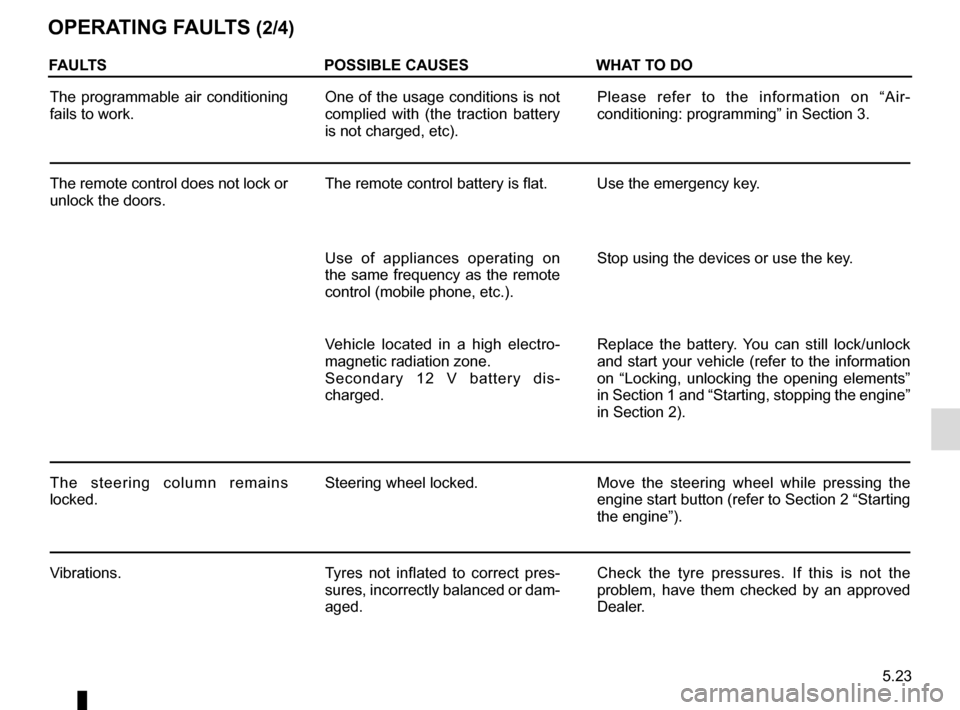
5.23
OPERATING FAULTS (2/4)
FAULTSPOSSIBLE CAUSESWHAT TO DO
The programmable air conditioning
fails to work. One of the usage conditions is not
complied with (the traction battery
is not charged, etc).Please refer to the information on “Air-
conditioning: programming” in Section 3.
The remote control does not lock or
unlock the doors. The remote control battery is flat. Use the emergency key.
Use of appliances operating on
the same frequency as the remote
control (mobile phone, etc.).Stop using the devices or use the key.
Vehicle located in a high electro-
magnetic radiation zone.
Secondary 12 V battery dis-
charged. Replace the battery. You can still lock/unlock
and start your vehicle (refer to the information
on “Locking, unlocking the opening elements”
in Section 1 and “Starting, stopping the engine”
in Section 2).
The steering column remains
locked. Steering wheel locked.
Move the steering wheel while pressing the
engine start button (refer to Section 2 “Starting
the engine”).
Vibrations. Tyres not inflated to correct pres-
sures, incorrectly balanced or dam-
aged. Check the tyre pressures. If this is not the
problem, have them checked by an approved
Dealer.
Page 208 of 214
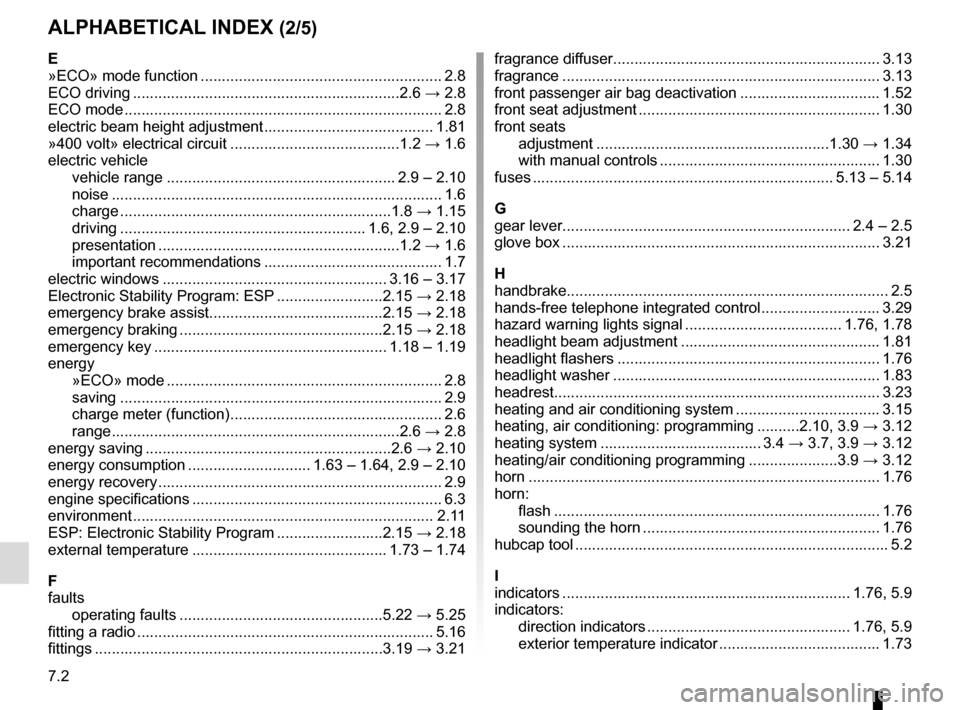
7.2
ALPHABETICAL INDEX (2/5)
E
»ECO» mode function ......................................................... 2.8
ECO driving ...............................................................2.6 → 2.8
ECO mode ........................................................................\
... 2.8
electric beam height adjustment ........................................ 1.81
»400 volt» electrical circuit ........................................1.2 → 1.6
electric vehicle vehicle range ...................................................... 2.9 – 2.10
noise ..................................................................\
............ 1.6
charge ................................................................1.8 → 1.15
driving .......................................................... 1.6, 2.9 – 2.10
presentation .........................................................1.2 → 1.6
important recommendations .......................................... 1.7
electric windows ..................................................... 3.16 – 3.17
Electronic Stability Program: ESP .........................2.15 → 2.18
emergency brake assist.........................................2.15 → 2.18
emergency braking ................................................2.15 → 2.18
emergency key ....................................................... 1.18 – 1.19
energy »ECO» mode ................................................................. 2.8
saving .................................................................\
........... 2.9
charge meter (function) .................................................. 2.6
range ..................................................................\
..2.6 → 2.8
energy saving ..........................................................2.6 → 2.10
energy consumption ............................. 1.63 – 1.64, 2.9 – 2.10
energy recovery ................................................................... 2.9
engine specifications ........................................................... 6.3
environment ............................................................\
........... 2.11
ESP: Electronic Stability Program .........................2.15 → 2.18
external temperature .............................................. 1.73 – 1.74
F
faults operating faults ................................................5.22 → 5.25
fitting a radio ...................................................................... 5.16
fittings ...............................................................\
.....3.19 → 3.21fragrance diffuser ............................................................... 3.13
fragrance ..............................................................\
............. 3.13
front passenger air bag deactivation ................................. 1.52
front seat adjustment ......................................................... 1.30
front seats adjustment .......................................................1.30 → 1.34
with manual controls .................................................... 1.30
fuses ....................................................................... 5.13 – 5.14
G
gear lever..............................................................\
...... 2.4 – 2.5
glove box ........................................................................\
... 3.21
H
handbrake...............................................................\
............. 2.5
hands-free telephone integrated control ............................ 3.29
hazard warning lights signal ..................................... 1.76, 1.78
headlight beam adjustment ............................................... 1.81
headlight flashers .............................................................. 1.76
headlight washer ............................................................... 1.83
headrest................................................................\
............. 3.23
heating and air conditioning system .................................. 3.15
heating, air conditioning: programming ..........2.10, 3.9 → 3.12
heating system ...................................... 3.4 → 3.7, 3.9 → 3.12
heating/air conditioning programming .....................3.9 → 3.12
horn ...................................................................\
................ 1.76
horn: flash ..................................................................\
........... 1.76
sounding the horn ........................................................ 1.76
hubcap tool ........................................................................\
.. 5.2
I
indicators .............................................................\
....... 1.76, 5.9
indicators: direction indicators ................................................ 1.76, 5.9
exterior temperature indicator ...................................... 1.73